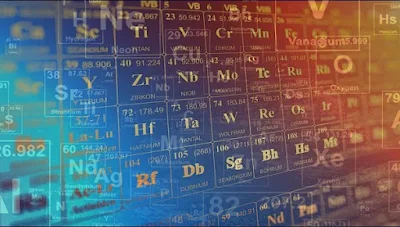The periodic table
In the periodic table, elements are organized into periods (horizontal rows) and groups (vertical columns). Period 6 of the periodic table includes the elements from atomic number 55 (Cesium, Cs) to atomic number 86 (Radon, Rn).
The elements in period 6 are:
1.Cesium (Cs) - Atomic number 55
2.Barium (Ba) - Atomic number 56
3.Lanthanum (La) - Atomic number 57
4.Cerium (Ce) - Atomic number 58
5.Praseodymium (Pr) - Atomic number 59
6.Neodymium (Nd) - Atomic number 60
7.Promethium (Pm) - Atomic number 61
8.Samarium (Sm) - Atomic number 62
9.Europium (Eu) - Atomic number 63
10.Gadolinium (Gd) - Atomic number 64
11.Terbium (Tb) - Atomic number 65
12.Dysprosium (Dy) - Atomic number 66
13.Holmium (Ho) - Atomic number 67
14.Erbium (Er) - Atomic number 68
15.Thulium (Tm) - Atomic number 69
16.Ytterbium (Yb) - Atomic number 70
17.Lutetium (Lu) - Atomic number 71
18.Hafnium (Hf) - Atomic number 72
19.Tantalum (Ta) - Atomic number 73
20.Tungsten (W) - Atomic number 74
21.Rhenium (Re) - Atomic number 75
22.Osmium (Os) - Atomic number 76
23.Iridium (Ir) - Atomic number 77
24.Platinum (Pt) - Atomic number 78
25.Gold (Au) - Atomic number 79
26.Mercury (Hg) - Atomic number 80
27.Thallium (Tl) - Atomic number 81
28.Lead (Pb) - Atomic number 82
29.Bismuth (Bi) - Atomic number 83
30.Polonium (Po) - Atomic number 84
31.Astatine (At) - Atomic number 85
32.Radon (Rn) - Atomic number 86
These elements exhibit various properties and are categorized into different groups based on their chemical similarities and properties.
How do 6th period in modern periodic table has 32 elements?
But the sixth period of the modern periodic table does not have 32 elements. It has 32 elements if you count the lanthanides and actinides, which are series of elements that are usually depicted separately below the main body of the periodic table.
In the main body of the periodic table, which consists of the s-block, p-block, and d-block elements, the sixth period contains 32 elements. However, this includes the transition metals and not just the elements from cesium (Cs) to radon (Rn).
Here's a breakdown of the number of elements in each block of the sixth period:
1.S-block: 2 elements (from cesium (Cs) to francium (Fr))
2.P-block: 6 elements (from radium (Ra) to radon (Rn))
3.D-block: 10 elements (from rutherfordium (Rf) to copernicium (Cn))
The total number of elements in the main body of the sixth period (s-block + p-block + d-block) is 2 + 6 + 10 = 18 elements.
Beyond these, the sixth period also includes the lanthanide series (from lanthanum (La) to lutetium (Lu)) and the actinide series (from actinium (Ac) to lawrencium (Lr)), totaling 14 elements each, making a total of 28 elements. When you add these to the 18 elements in the main body of the sixth period, you get a total of 46 elements in the sixth period.
So, the number of elements in the sixth period of the modern periodic table is not 32, but rather 46, when you include both the main body elements and the lanthanides and actinides.
How many elements are there ? how many elements occur naturally ?
As of my last update, there are 118 known elements in the periodic table. Out of these, approximately 94 elements occur naturally on Earth. The remaining elements are synthetic, meaning they are created artificially in laboratories and do not occur naturally in significant quantities on Earth. These synthetic elements are typically produced through nuclear reactions, often involving particle accelerators or nuclear reactors.
How many state are there in elements ?
How many elements are there in 2019 ?
As of 2019, there are 118 known elements in the periodic table. This number includes all the elements from hydrogen (atomic number 1) to oganesson (atomic number 118). These elements have been discovered and confirmed through scientific research and experimentation.
How many elements are there in 5period
The fifth period of the periodic table consists of elements from atomic number 37 (Rb) to atomic number 54 (Xe). Therefore, the fifth period contains 18 elements.
Name a nonmetal which has only one electron in its outermost shell.
An example of a nonmetal with only one electron in its outermost shell is hydrogen (H). Hydrogen has one electron in its outermost shell, making it a member of Group 1 in the periodic table.
Which of the following is the only nonmetal that appears as a liquid in its elemental form under standard conditions?
The only nonmetal that appears as a liquid in its elemental form under standard conditions (at room temperature and pressure) is bromine (Br). Bromine is a halogen and is the only nonmetal that exists in a liquid state under standard conditions.
What is the most reactive nonmetal in the periodic table?
The most reactive nonmetal in the periodic table is fluorine (F). Fluorine belongs to Group 17 (also known as Group VIIA or the halogens) and is located at the top of this group. It is the most electronegative element, meaning it has a strong tendency to attract electrons, and it readily reacts with almost all other elements, especially metals, to form compounds. Fluorine is highly reactive and can even react violently with certain substances, making it the most reactive nonmetal.
what is non metal called nonmetal ?
In chemistry, nonmetals are elements that lack the properties of metals. They typically have properties such as low conductivity, brittle solids, low melting and boiling points, and tend to gain electrons to form anions in chemical reactions. The term "nonmetal" is used to collectively refer to this group of elements in the periodic table. So, a nonmetal is simply called a "nonmetal."
